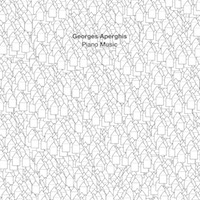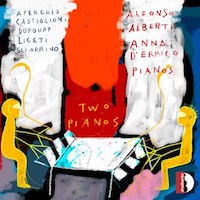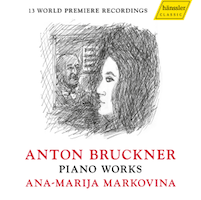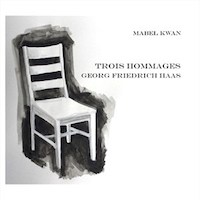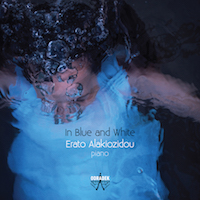Piano Factory 25.
|
Grant Chu Covell [November 2018.]
“Piano Music.” Georges APERGHIS: Les secrets élémentaires (1998); Conversation X (1985); Dans le mur (2007); Pièce pour jeunes pianistes (2004). Lenio Liatsou (pno). GOD Records 46 (1 LP) (http://godrec.com). Liberated from traditional scale passages and gestures, Aperghis’ particular brand of energetic filigree is unfurled across four piano works. Les secrets élémentaires intertwines a sequence of unrelated pages in quick succession. The pianist must effortlessly articulate rapid passages suggesting anxious birds or fretting machines, though the gestures are not that far removed from Debussy (transposed and sped up). Conversation X instructs the pianist to vocalize alongside a prepared piano. Should you have encountered Aperghis’ theatrical works, this piece falls into that vein, including primitive phonemes and vocal sounds to create a charged, unsettling experience. Liatsou delivers light soprano warbling and guttural gasps with panache. Dans le mur blends solo piano with multiple pianos blurred on tape. Here too the pace is frenetic as the soloist waxes and wanes through a galaxy of double upon double. Pièce pour jeunes pianistes is a slower, brief encore, less virtuosic, but with the same intensity and peculiar motives found in Les secrets élémentaires.
“Two Pianos.” Salvatore SCIARRINO: Sonata (1966). György LIGETI: Drei Stücke für zwei Klaviere (1976). Georges APERGHIS: Alter-Face (2004). Hugues DUFOURT: Soleil de proie (2005). Niccolò CASTIGLIONI: Omaggio a Edvard Grieg (1981). Alfonso Alberti, Anna D’Errico (pno). Stradivarius STR 37058 (1 CD) (http://www.stradivarius.it/). Sciarrino’s feathery two-movement Sonata suggests unfinished work: We have a Veloce and a Menuet – Trio. In high tessitura, the pianists warble and trill with splashing chords and grace notes. Given the consistent fluttering at the pianos’ utmost end, it’s impossible not to hear repetition, and I wonder if there are numerous explicit repeats. Ligeti’s Three Pieces return to traditional range, and the duplications here are more akin to minimalism and process. Ligeti wore his influences proudly, cited explicitly in No. 2’s title, “Selbstportrait mit Reich und Riley (und Chopin ist auch dabei).” Aperghis’ Alter-Face continues the mechanical theme at a pervasive triple-p, adding mystery and smudged Expressionism to nervous murmuring. Dufourt takes the pair in an entirely different direction, exploring subdued Romanticism with grand dissonant chords. More conventional and easier to align with contemporary trends, I find it rambling and sluggish in comparison, and prefer the warmth of Castiglioni’s rhapsodic duo which slithers back to the top of the duos’ tessitura and offers octave melodies suggesting Messiaen more than Grieg.
“Piano Works.” Anton BRUCKNER: Aus Kitzlers Studienbuch (1861-63); Lancier-Quadrille, WAB 120 (1850); Drei kleine Stücke zu vier Händen, WAB 124 (1853-55)*; Quadrille zu vier Händen, WAB 121 (1854)*; Klavierstück in Es-Dur, WAB 119 (1856); “Stille Betrachtung an einem Herbstabend,” WAB 123 (1863); Steiermärker, WAB 122 (1850); Fantasie, WAB 118 (1856); Erinnerung, WAB 117 (1868). Ana-Marija Markovina, Rudolf Meister* (pno). Hänssler Classic HC17054 (1 CD) (http://www.haensslerprofil.de/). Everybody has to learn, and here’s a chance to hear Bruckner evolving. The Aus Kitzlers Studienbuch reflects two years of the late bloomer’s studies with Otto Kitzler in Linz, and includes tidy explorations of short forms and basic counterpoint. (The notebook also contains orchestration exercises, and first chamber and orchestral works not included here.) The four-hand dance pieces suggest functional Schubert. Only in the awkward but memorable WAB 118 Fantasie (accidentally indicated as WAB 119) do we hear a modulating chromatic theme that suggests where Bruckner was going. The duets are played sensitively. Markovina explores less mainstream repertoire with perception (prior projects have included C.P.E. Bach, Luise Adolpha Le Beau and Anton Urspruch), especially in the recital’s concluding set pieces. This music may be simple, but Markovina sensibly achieves the occasionally thick voicing and oddly grandiose maneuvering.
“Trois Hommages.” Georg Friedrich HAAS: Hommage à György Ligeti (1984); Hommage à Josef Matthias Hauer (1982); Hommage à Steve Reich (1982). Mabel Kwan (pno). New Focus Recordings FCR214 (1 CD) (http://www.newfocusrecordings.com/). Together, these three Hommages spread to 71 minutes and ask for a single pianist simultaneously to play two pianos tuned a quarter tone apart (each piano is in 12-note equal temperament). Online visuals show two pianos placed at right angles and Kwan positioned to reach all the ivories. We can infer – and what we hear supports this – that each hand is dedicated to a single instrument. Happily leveraging minimalist patterns, Haas has written three pieces that introduce and explore a 24-pitch microtonal universe. Ligeti, Hauer and Reich are three composers he has admired (least familiar Hauer arrived at a 12-tone theory ahead of Schoenberg). The Hommage for Ligeti is chordal, a fast and constant drumbeat as notes are picked from the 24-note gamut. It starts with the tuning system we know, then adds notes from the other keyboard to create a tangy haze. The piece for Hauer is a moderately paced constant stream of ascending scale patterns, suggesting ever so slightly WTC: I’s opening Prelude. With unexpected accents, the beat can be elusive and not just because after a few minutes another is folded in. The Reich movement offers a tapestry of moving notes in a constant pulse. The microtonal colors are bolder, the dissonant tinges suggesting passing ambulances. Repeating pitches reveal compound rhythms. We’ve encountered Kwan before as member of Ensemble Dal Niente.
“Quattro Mani: Re-Structures.” Paul LANSKY: Out of the Blue (2015)1. Poul RUDERS: Cembal D’Amore (Second Book) (2007)2. Tod MACHOVER: Re-Structures (2015)3. György KURTÁG: Életút (Lebenslauf), Op. 32 (1992)4. Ofer BEN-AMOTS: Tango for the Road (2015)5. Steven Beck1,3,4,5, Susan Grace1,2,3,4,5 (pno), Steven Beck2 (hpsi), Andy Stevens4, Sergei Vassiliev4 (basset horn). Bridge 9496 (1 CD) (http://www.bridgerecords.com/). Over before it begins, Lansky’s tidbit could be a gleeful minimalist perusing Chopin or Stravinsky. It derives from another Lansky piece which in turn was inspired by a Ligeti Étude. Two works on this program distinctly nudge the notion of two pianos: Ruders’ suite of eight pieces asks the piano and harpsichord pairing to tackle challenges in balance and technique. The ornery tonality is especially crunchy on the plucked instrument. Scored for an impossibly rare ensemble, Kurtág’s canonic Életút, for two pianos tuned a quarter-tone apart and a pair of basset horns, suggests misunderstood folk music. Ben-Amot’s Tango closes the program with a Romantic and bittersweet example of a familiar genre. The title work may be the least distinctive of the bunch. Machover became Boulez’s colleague at IRCAM, and this piece for two pianos and live electronics intends to expand upon Boulez’s liminal Structures. I have had the advantage of hearing Quattro Mani perform this one live, twice in fact, on a concert including Boulez, Lerdahl and Rzewski back in 11/2017. The electronics may enhance the aura, but no secrets are to be discovered on replays. Written in honor of Boulez’s 90th birthday, the impression is of an overworked improvisation.
“In Blue and White.” Aspasia NASOPOULOU: Olinda (“Hidden City”) (2012); Ochto (2016). Theodore ANTONIOU: Seven Rhythmic Dances (2000). Giorgos KOUMENDAKIS: Three Mediterranean Herbs: Thyme, Mint and Sage, Grouper, Praying Mantis, and The Caterpillar and the Treble-Bar of L. van B. from Mediterranean Desert (1998 / 2000). George COUROUPOS: 11/8 with Passion, Countless Eighths – Always with Love, and 13/8 with Love from Three Times the Love, Op. 43 (1984; rev. 2016). Kostas SIEMPIS: Chorales in Memory (2011). Costas TSOUGRAS: To Endeka (Eleven): Study on Yannis Constantinidis from Three Stylistic Studies (2011). Stathis GYFTAKIS: First Dream (2003); Deep Blue… Almost Black (2003); Nightmares (2003). Anastassis PHILIPPAKOPOULOS: Piano Piece (2015); Piano Piece (2014). Joseph PAPADATOS: Anadyomene (“Rising from the Sea”), Op. 108 (2016). Dimitrios SKYLLAS: Miniatures II and VI from Nine Miniatures for the Universe Mirroring Earth (2011/12). Giorgos KYRIAKAKIS: Alfred auf Yaros (2016). Leontios HADJILEONTIADIS: (Con)Sequences. In a Yannis Constantinidis Style, Op. 84 (2011). Calliope TSOUPAKI: Lasting Sounds of a Deep Sea (1988). Vassilis KITSOS: Of Every Breath (2017). Erato Alakiozidou (pno). Odradek ODRCD343 (1 CD) (http://www.odradek-records.com/). Twenty-five tracks (nearly 80 minutes) offer a range of contemporary Greek piano pieces, something for everyone. Alakiozidou’s delivered intent is to show there is more out there than just Xenakis, Skalkottas and Christou. Many of these pieces were written for her. Composers and styles are stirred up, but it is possible to detect a recurring theme of nature. Nasopoulou’s first, Olinda, is especially spare, but the most austere belong to Philippakopoulos who is associated with the Wandelweiser group and is represented by two short pieces containing single notes over pedal. Familiar forms representing folk music appear in Antoniou’s bitty tonal Dances. The unabashedly Romantic Couroupos threesome recalls sweet and simple things from the 19th-century’s start. Tsougras and Hadjileontiadis’ offerings allude to the influential composer Yannis Constantinidis (1903-1984). Most pieces keep hands on the keys, but after what seems like a straightforward folksong, Hadjileontiadis (Con)Sequences veers experimental and asks the pianist to play on the instrument body. Kyriakakis’ Alfred auf Yaros is a memorial to Schnittke, spanning the keyboard, combining different styles and moods. Progressions recalling Beethoven lurk in Koumendakis’ The Caterpillar. On revisits different pieces came to the fore while others receded: Gyftakis’ First Dream and Tsoupaki’s Lasting Sounds of a Deep Sea offer particular lyricism.
Antoniou, Aperghis, Ben-Amots, Bruckner, Castiglioni, Couroupos, Dufourt, Gyftakis, Haas, Hadjileontiadis, Kitsos, Koumendakis, Kurtág, Kyriakakis, Lansky, Ligeti, Machover, Nasopoulou, Papadatos, Philippakopoulos, Ruders, Sciarrino, Siempis, Skyllas, Tsougras, Tsoupaki
[More Grant Chu Covell, Piano Factory]
[More
Antoniou, Aperghis, Ben-Amots, Bruckner, Castiglioni, Couroupos, Dufourt, Gyftakis, Haas, Hadjileontiadis, Kitsos, Koumendakis, Kurtág, Kyriakakis, Lansky, Ligeti, Machover, Nasopoulou, Papadatos, Philippakopoulos, Ruders, Sciarrino, Siempis, Skyllas, Tsougras, Tsoupaki]
[Previous Article:
EA Bucket 27.]
[Next Article:
Used Bin Troll Tweets JJ.]
|
